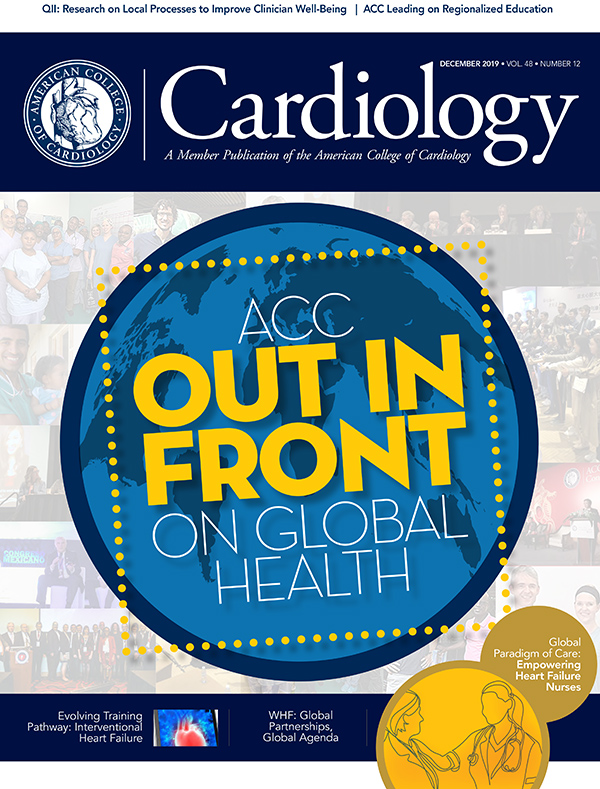Quick Reads Feature | The Pulse of ACC
Applied AI in Health Care; Disruptive Innovations in Health Care track at CES 2010; More.
Findings from ACC's TRANSFORM LDL-C Risk Initiative Suggest Significant Gaps in Cholesterol Management

A large majority of patients with atherosclerotic cardiovascular disease (ASCVD) in the PINNACLE Registry are not achieving guideline recommended LDL-C goals on a statin alone, according to early findings presented last month at AHA 2019 in Philadelphia.
Researchers looked at patients enrolled in the PINNACLE Registry from 2013 to March 2019 to examine patterns of LDL-C goal achievement and lipid-lowering therapy in adults with ASCVD. The 2018 ACC/AHA Guideline on the Management of Blood Cholesterol recommends 70 mg/dl LDL-C as a threshold for several groups of high-risk patients when considering treatment approach.
According to interim data from Phase 1 of the initiative, of the approximately 1.9 million patients with ASCVD in the PINNACLE Registry, 21.1 percent had no history of lipid-lowering therapy use and 84.5 percent did not meet the LDL-C goal of <70 mg/dL.
In a subset of approximately 1.3 million patients who were only prescribed a statin, 67 percent did not achieve their LDL-C goal of <70 mg/dL. Overall, the percentages of patients only on a statin achieving LDL-C <70 mg/dL, between 70 and 99 mg/dL and ≥100 mg/dL were 32.9 percent, 41.1 percent and 25.9 percent, respectively.
Among patients with ASCVD, younger patients (18 to 64 years old), women, African-Americans and those with hypertension were least likely to achieve LDL-C <70 mg/dL while on a statin.
"Large groups of patients with ASCVD are not achieving low enough LDL-C levels, which puts them at greater risk of recurrent cardiovascular events and death," sys Dharam Kumbhani, MD, SM, FACC, senior author of the study and an associate professor of medicine at UT Southwestern Medical Center.
"It's apparent that large gaps exist and that more efforts are needed in implementing the cholesterol guidelines. Next steps are examining what barriers exist in achieving these treatment goals and how to address these barriers."
In response to these large gaps in LDL-C goal achievement, the ACC, in partnership with Sanofi and Regeneron Pharmaceuticals, established the TRANSFORM LDL-C Risk initiative to identify high-risk patients with a history of cardiovascular events related to ASCVD and to begin exploring barriers to LDL-C goal achievement.
This initiative involves a collaborative, regional network of practices that can share best practices and influence future ACC work in this space. Additional phases of the program and corresponding results will be released in the future.
An ACC Chapter, Section Success Story For Improving Patient Access
A collaboration between the North Carolina Chapter of the ACC and the ACC Prevention Member Section, in partnership with the North Carolina Association of Free and Charitable Clinics (NCAFCC), has helped to improve the cardiovascular health care of the most vulnerable patients in NC by providing free lipid-lowering medications and clopidogrel.
In a recent Leadership Page published in the Journal of the American College of Cardiology, George A. Stouffer, MD, FACC; William B. Abernethy, MD, FACC; James P. Zidar, MD, FACC; and B. Hadley Wilson, MD, FACC, describe the initiative and what they say is a "gratifying example in achieving the ACC Mission and Vision."
Over two years, through the program, there was an increase in patients receiving medications and significant decreases in total cholesterol and LDL levels in the clinics that provided free medications. Programs like this may improve adherence and medical costs and are also a way to reach society's most vulnerable patients.
"In summary, our North Carolina project shows the feasibility of a partnership between a medical specialty society and an association of free and charitable clinics and demonstrates the potential impact this partnership could have on the health of vulnerable patients," the authors write.
"Based on our success, similar programs could be developed that include different medications, different disease groups, and different medical specialty societies."
On the Right Pathway!
The first assessment windows for the nearly 1,400 people enrolled in the Collaborative Maintenance Pathway (CMP) have been successfully completed. The CMP, which is designed to integrate lifelong learning with assessment and is delivered through a special version of ACC's ACCSAP, provides an option outside of the high-stakes 10-year exam for those clinicians seeking to maintain American Board of Internal Medicine certification.
With the CMP option, cardiologists complete required learning in specific cardiovascular topics accompanied by a shorter assessment on those topics every year over a 5-year period. The first performance windows occurred Nov. 6-12 and Dec. 4-10.
Looking ahead, the CMP will be available for the following specialties in 2020:
- Cardiovascular Disease (delivered through ACCSAP)
- Interventional Cardiology (delivered through CathSAP, which is developed in collaboration with SCAI)
- Clinical Cardiac Arrhythmias & Electrophysiology (delivered through EPSAP, which is developed in collaboration with HRS)
- Advanced Heart Failure & Transplant Cardiology (delivered through HFSAP, which is developed in collaboration with HFSA)
Assessment dates for 2020 are being finalized and expected to be announced in Q1. To learn more about the CMP option, visit ACC.org/CMP.
Call For Applications: Editor-in-Chief of JACC: Clinical Electrophysiology
The ACC Publications Committee is seeking applications for the position of Editor-in-Chief of JACC: Clinical Electrophysiology. The new Editor-in-Chief will serve a five-year term beginning in March 2020.
JACC: Clinical Electrophysiology provides a critical forum for original research and state-of-the-art reviews from cardiology, cardiovascular surgery, neurology, outcomes research and related fields. Experimental and preclinical work that directly relate to diagnostic or therapeutic interventions are also covered.
Interested applicants should meet the following qualifications:
- Current academic appointment in clinical electrophysiology, and strong evidence of scholarly pursuits.
- Broad and in-depth knowledge of the field of cardiac arrhythmias.
- Substantial experience in writing, editing and reviewing scientific articles.
- Ability to plan, coordinate and manage tasks associated with journal publication and production.
- Demonstrated ability in administration and leadership.
- Intention to cultivate the journal as a primary interest; estimated time commitment of 30 percent.
- Understanding of and appreciation for the potential and possibilities of new media, digital and electronic publication; and social media.
- Understanding of the Open Access publishing model, trends and competitive landscape.
- The ideal candidate will have served in a significant leadership role in a journal (e.g., Editor, Deputy Editor, Associate Editor or Assistant Editor).
The deadline to apply is Jan. 1. Applicants should send a letter of application addressing their qualifications for the position, along with a brief vision statement for the journal.
Letters should be addressed to ACC Publications Committee, and sent via e-mail to kmurphy@acc.org and mpayne@acc.org.
Upcoming JACC Collaboration Will Provide Important Insights Into Global CVD Burden
Starting next year, the global, regional, and U.S. burden of cardiovascular disease and risk factors ranging from high blood pressure to air pollution will be published in JACC as part of a collaborative effort involving the Journal, the National Heart, Lung, and Blood Institute (NHLBI) and the Institute for Health Metrics and Evaluation (IHME) at the University of Washington.
A recent JACC Editor's Page from Editor-in-Chief Valentin Fuster, MD, PhD, MACC; George A. Mensah, MD, of NHLBI; and Gregory A. Roth, MD, MPH, of IHME, outlines the reasons behind the collaboration and provide an overview of what data will be presented. Of note, the 15 most common causes of cardiovascular disease deaths (including congenital heart defects) and 13 related risk factors will form the core of data presented.
"Cardiovascular diseases (CVDs), consisting of ischemic heart disease, stroke, heart failure, peripheral arterial disease, and a number of other cardiac and vascular conditions, constitute the leading cause of global mortality and are a major contributor to reduced quality of life," they write. "…Taken together with data on CVD and risk factor prevalence, these summary measures of health can be invaluable for cardiologists, other clinicians, and public health experts. They provide crucial population-level information that can guide action for CVD and risk factor prevention, treatment, and control at global, regional, national, and subnational levels."
Clinical Topics: Anticoagulation Management, Arrhythmias and Clinical EP, Cardiovascular Care Team, Congenital Heart Disease and Pediatric Cardiology, Dyslipidemia, Heart Failure and Cardiomyopathies, Prevention, Vascular Medicine, Atherosclerotic Disease (CAD/PAD), Implantable Devices, SCD/Ventricular Arrhythmias, Atrial Fibrillation/Supraventricular Arrhythmias, Congenital Heart Disease, CHD and Pediatrics and Arrhythmias, CHD and Pediatrics and Prevention, CHD and Pediatrics and Quality Improvement, Homozygous Familial Hypercholesterolemia, Lipid Metabolism, Nonstatins, Novel Agents, Statins, Acute Heart Failure, Hypertension
Keywords: ACC Publications, Cardiology Magazine, Adolescent, African Americans, Air Pollution, Arrhythmias, Cardiac, Atherosclerosis, Certification, Cholesterol, Cholesterol, LDL, Cardiovascular Diseases, Cytidine Monophosphate, Electronic Mail, Electrophysiology, Factor XIII, Feasibility Studies, Goals, Heart Defects, Congenital, Heart Failure, Hydroxymethylglutaryl-CoA Reductase Inhibitors, Hypercholesterolemia, Hypertension, Leadership, Myocardial Ischemia, National Heart, Lung, and Blood Institute (U.S.), Neurology, Outcome Assessment, Health Care, Peripheral Arterial Disease, Prevalence, Quality of Life, Public Health, Quality Indicators, Health Care, Risk Factors, Registries, Stroke, Societies, Medical

